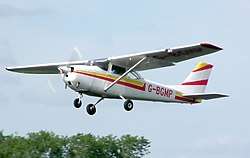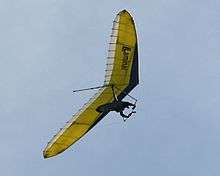General aviation in Europe
General aviation (GA) has been defined as a civil aircraft operation other than a commercial air transport flight operating to a schedule. Although the International Civil Aviation Organization (ICAO) excludes any form of remunerated aviation from its definition, some commercial operations are often included within the scope of General Aviation (GA). General aviation refers to all flights other than military and scheduled airline flights, both private and commercial.

In 2003 the European Aviation Safety Agency (EASA) was established as the central EU regulator, taking over responsibility for legislating airworthiness and environmental regulation from the national authorities.[1]
Definitions
General aviation flights range from gliders and powered parachutes to large, non-scheduled cargo jet flights. The sector operates business jets, rotorcraft, piston and jet-engined fixed-wing aircraft, gliders of all descriptions, and lighter than air craft. Other commercial GA activities are aerial work, such as surveying and air ambulances, and flight training.
.jpg)
The International Civil Aviation Organization defines general aviation as "an aircraft operation other than a commercial air transport operation or an aerial work operation." It defines commercial air transport (CAT) as "an aircraft operation involving the transport of passengers, cargo or mail for remuneration or hire", and aerial work as "an aircraft operation in which an aircraft is used for specialized services such as agriculture, construction, photography, surveying, observation and patrol, search and rescue, aerial advertisement, etc."[2]
Organisations in the United Kingdom (UK) describe GA in less restrictive terms that include elements of commercial aviation. The British Business and General Aviation Association interprets it to be "all aeroplane and helicopter flying except that performed by the major airlines and the Armed Services".[3] The General Aviation Awareness Council applies the description "all Civil Aviation operations other than scheduled air services and non-scheduled air transport operations for remuneration or hire".[4] For the purposes of a strategic review of GA in the UK, the Civil Aviation Authority (CAA) defined the scope of GA as "a civil aircraft operation other than a commercial air transport flight operating to a schedule", and considered it necessary to depart from the ICAO definition and include aerial work and minor CAT operations.[5] The major part of the General Aviation is the Sport and Recreational Aviation.
UK
Facts 2005: 26,000 GA aircraft registered. between 1.25 and 1.35 million hours flown. 28,000 Private Pilot Licence holders (for 47,000 Licences in total), 10,000 certified glider pilots. Some of the 19,000 pilots who hold professional licences are also engaged in GA activities. more than 1,800 aerodromes and landing sites, ranging in size from large regional airports to farm strips, over 80 per cent of GA activity is conducted at 134 of the larger aerodromes.

There are an estimated 27,000 civil aircraft registered in the UK, 96 per cent of which are engaged in GA activities.
In 2005 the GA fleet comprised 9,000 fixed-wing aircraft, 4,100 microlights, 1,300 helicopters, 1,800 airships/balloons, 2,500 gliders and some 7,000 hang gliders.
Estimates put the number of foreign-registered GA aircraft based in the UK at 900.[6]
Regulation
The objective of regulation is to "promote high standards of safety in all aspects of aviation". Efforts focus on assuring appropriate standards of airworthiness, pilot licensing, the rules for the movement of aircraft and equipment to be carried.
In 2003 the European Aviation Safety Agency (EASA) was established as the central EU regulator, taking over responsibility for legislating airworthiness and environmental regulation from the national authorities. Proposed developments seek to establish EASA as the single authority throughout the EU, taking over from individual member states the power to regulate all aviation other than that specifically excluded from the scope of EASA.[7]
The EASA launched a working group to update of the regulation. This MDM.032 working group was tasked with developing a concept for better regulation in General Aviation.
European Light Aircraft (ELA).
The main focus is on standards of airworthiness and pilot licensing, and the objective is to promote high standards of safety. At the lighter end of the GA spectrum some regulatory authority is devolved to representative bodies, with gliding currently in transition from a self-regulatory model to more formal governance by EASA.
Airspace regulation necessary to protect an increasing number of commercial air transport (CAT) operations has reduced the area in which GA flights can be freely conducted. The growth in CAT is also making access to larger airports more difficult for the GA sector, and smaller aerodromes are vulnerable to closure and re-development for more profitable uses. The UK planning system has no remit to consider the national significance of GA public transport operations, and generally does not favour the development of smaller aerodromes catering to the GA market.
Evolution of the activity
The single most common class of aircraft is the fixed-wing light aircraft associated with traditional GA, but the main area of growth over the last 20 years has been in the use of more affordable aircraft, such as microlights, amateur built aeroplanes, and smaller helicopters. The most important recent developments for small aircraft been the introduction of advanced avionics (including GPS) that were formerly found only in large airliners, and the introduction of composite materials to make small aircraft lighter and faster. Ultralight and homebuilt aircraft have also become increasingly popular for recreational use, since in most countries that allow private aviation they are much less expensive than certified aircraft.
GA Safety in Europe
About three accidents per day are reported in Europe. As the reporting of every GA accidents and incidents is not mandatory everywhere, these figures may be higher. However, most major accidents are likely to be reflected due to involvement of outside authorities. The EASA and the NAAs supports and encourages the collection of light aircraft accident data in order to provide more in-depth statistics and analysis.
In the UK, there were 27 fatal accidents involving GA aircraft in 2007, resulting in the loss of 48 lives. These compare with 16 accidents claiming a total of 19 lives the previous year, and although the 2007 statistics are higher than average, they are not exceptional.[8]
European General Aviation associations
| Flag |
Member States |
National Aero Clubs |
Micro-light associations |
Gliding associations |
Link |
|---|---|---|---|---|---|
| EU-28 | Europe-airsports.fai.org | EMF | * | .eu | |
| Austria | Austrian Aero Club | -- | -- | .at | |
| Belgium | Koninklijke Belgische Aëroclub/Aero Club Royal de Belgique | -- | -- | .be | |
| Bulgaria | - | Bulgarian Association of Light Aviation | -- | .bg | |
| Cyprus | Cyprus Airsports Federation | -- | -- | .cy | |
| Czech Republic | Aero Club of the Czech Republic | Light Aircraft Association of the Czech Republic | -- | .cz | |
| Denmark | Denmark Royal Danish Aero Club | Danish Ultra Light Union (DULFU) | -- | .dk | |
| Estonia | - | -- | -- | .ee | |
| Finland | Finnish Aeronautical Association | Experimental ja Ultrakevyt Toimikunta (EUT) Finland | -- | .fi | |
| France | Fédération Française Aéronautique | Fédération Française de Planeur Ultra-léger Motorisé | -- | .fr | |
| Germany | German Aero Club | Deutscher Ultraleichtflugverband e.V. | -- | .de | |
| Greece | Hellenic Aeronautical and Airsports Federation | -- | -- | .gr | |
| Hungary | Hungarian Aeronautical Association | -- | -- | .hu | |
| Ireland | National Aero Club of Ireland | -- | -- | .ie | |
| Italy | Aero Club of Italy | -- | -- | .it | |
| Latvia | Latvian Aero Club | -- | -- | .lv | |
| Lithuania | Lithuanian Aero Club (LAK) | ULOPF, Ultralengvų orlaivių pilotų federacija | Lithuanian Gliding Sport Federation | .lt | |
| Luxembourg | Luxemburg Aeronautic Federation | -- | -- | .lu | |
| Malta | - | -- | -- | .mt | |
| Netherlands | KNVvL, Royal Netherlands Aeronautical Association | -- | -- | .nl | |
| Norway | Norwegian Air sports Association | -- | -- | .no | |
| Poland | Aero Club of Poland | -- | -- | .pl | |
| Portugal | Aero Club de Portugal (AeCP) | Associação Portuguesa de Aviação Ultraleve (APAU) | -- | .pt | |
| Romania | Romanian Aeroclub | - | -- | .ro | |
| Serbia | Aeronautical Union of Serbia | -- | -- | .rs | |
| Slovakia | Slovak National Aeroclub | -- | -- | .sk | |
| Slovenia | http://www.lzs-zveza.si/ | -- | -- | .si | |
| Spain | Royal Aero Club of Spain | -- | -- | .es | |
| Sweden | Swedish Airsports Association | -- | -- | .se | |
| United Kingdom | Royal Aero Club of the United Kingdom | British Microlight Aircraft Association | -- | .uk |
See also
Gliding associations
| Country | Associations |
|---|---|
| Europe | European Gliding Union |
| Austria | Austrian Aero-Club - Section Gliding |
| Belgium | Belgian Gliding Federation |
| Bulgaria | |
| Cyprus | |
| Czech Republic | Aero Club of Czech Republic |
| Denmark | Dansk Svaeveflyver Union |
| Estonia | |
| Finland | Finnish Aeronautical Association |
| France | Fédération Française de Vol en Planeur |
| Germany | Deutscher Aero Club e.V. / German Aero Club e.V.
Sportfachgruppe Segelflug / Gliding Section |
| Greece | |
| Hungary | Magyar Vitorlázórepülő Szövetség |
| Iceland* | |
| Ireland | Irish Gliding and Soaring Association |
| Italy | Federazione Italiana di Volo a Vela |
| Latvia | |
| Liechtenstein | |
| Lithuania | Lietuvos sklandymo sporto federacija |
| Luxembourg | Fédération Aéronautique Luxembourgeoise |
| Malta | |
| Netherlands | Royal Neth. Aeronautical Association - Gliding Department |
| Norway* | Norsk Aero Klubb - Seilflyseksjonen |
| Poland | Aero Club of Poland |
| Portugal | |
| Romania | Romanian Aeroclub |
| Slovakia | Slovak National Aeroclub |
| Sweden | Swedish Soaring Federation |
| Switzerland* | Aéro-Club der Schweiz |
| Slovenia | Letalska Zveza Slovenija - Gliding Section |
| Spain | |
| Turkey | Turkish Aeronautical Association |
| United Kingdom | British Gliding Association |
References
- "5". Strategic Review of General Aviation in the UK (PDF). CAA. July 2006. pp. 52–53, paras. 5.18–5.24. Archived from the original (PDF) on 2009-02-25. Retrieved 2008-06-04.
- "Regulatory Review of General Aviation in the United Kingdom" (PDF). CAA. 2006-07-06. pp. 3–1 (section 3.1) and p. D-1 (Annex D). Archived from the original (PDF) on 2009-02-25. Retrieved 2008-06-03.
- "What is General Aviation?". British Business and General Aviation Association. Archived from the original on 2008-12-18. Retrieved 2008-06-03.
- "What is General Aviation?". General Aviation Awareness Council. 2006-07-06. Retrieved 2008-06-03.
- "Overview of the Strategic Review". Strategic Review of General Aviation in the UK (PDF). CAA. July 2006. p. i, paras. 9–10. Archived from the original (PDF) on 2009-02-25. Retrieved 2008-06-04. This article uses the CAA description to define the scope of general aviation in the UK, on the basis that this organisation is the regulatory body for aviation in the UK and the publisher of a key source.
- "Overview of the Strategic Review". Strategic Review of General Aviation in the UK (PDF). CAA. July 2006. pp. iii–iv, paras. 17, 19 & 20. Archived from the original (PDF) on 2009-02-25. Retrieved 2008-06-04.
- "5". Strategic Review of General Aviation in the UK (PDF). CAA. July 2006. pp. 52–53, paras. 5.18–5.24. Archived from the original (PDF) on 2009-02-25. Retrieved 2008-06-04.
- "SRG Safety Plan 2008 Update" (PDF). CAA. June 2008. p. 49. Archived from the original (PDF) on 2009-02-25. Retrieved 2008-06-22.